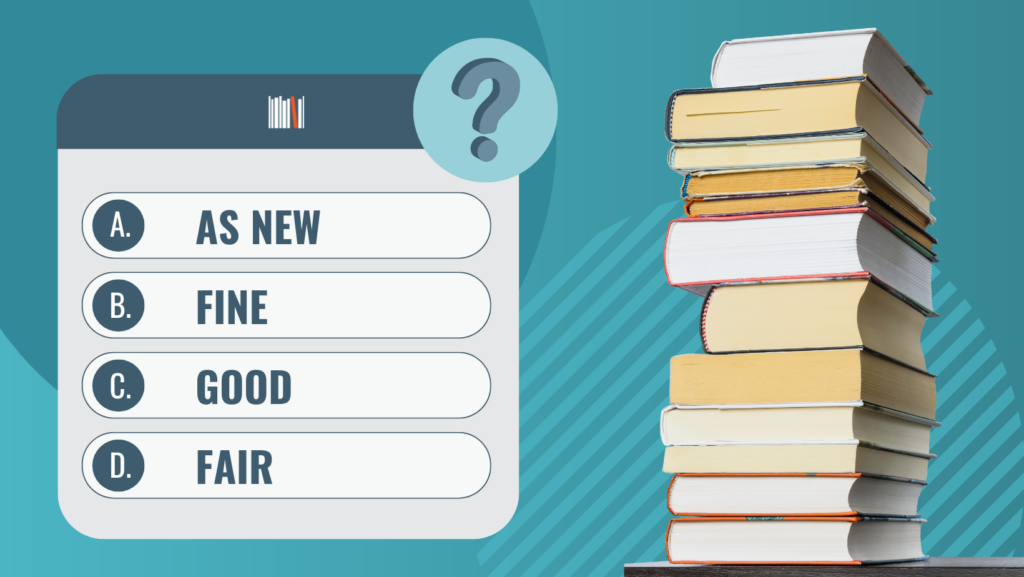
In this article, we’ve prepared a complete used book condition guide you can refer to whenever you need to understand how the book condition rating system works and how different platforms rate used books they sell.
We’re positive that if you’ve ever bought a book on Amazon or in an online store at least once, you must have seen one of these descriptions: “As new,” “Very Good,” “Acceptable,” etc. Moreover, you know these terms quite well if you resell books.
Over the years, a set of terms to rate used books and their conditions have been formed. First used mostly by publishers and booksellers, it’s grown into a full-scale vocabulary and now helps understand the book’s state and value when bought and sold online.
Depending on the online store, the set of terms defining used book conditions may vary; however, we’ll cover a few universal ones in this article with examples from different booksellers. Each of these terms conveys details regarding the characteristics and features of a used book, making clear what to expect and what not to expect: from light creasing to water damage.
- General Book Condition Grades Explained
- Book Condition Rating System Examples
- Book Condition Grades Comparison Chart
General Book Condition Grades Explained
As New
This pretty much covers it: the book looks new, and it’s probably never been read (or even opened, regardless of the fact it was published a while ago), so there are no signs of wear at all. It doesn’t open easily and prefers to stay in a closed condition. Here’s how booksellers, AbeBooks, for example, describe this condition:
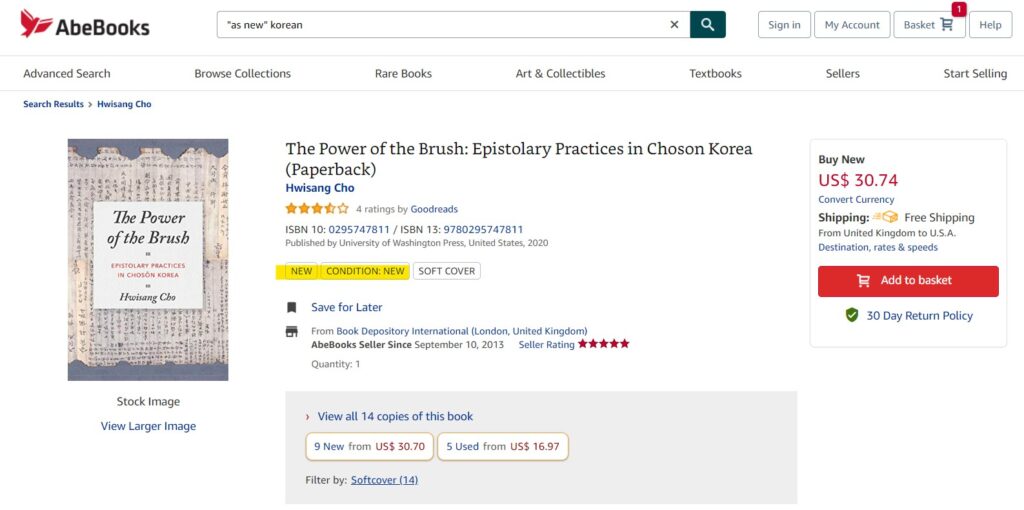
Fine (F or FN)
Fine is the next condition following As New, which describes the books that may have been opened or read but quite carefully so that there’s no trace left. There’s no defect or damage detectable, with both the jacket and the pages being in great condition. Here’s an example from Biblio:
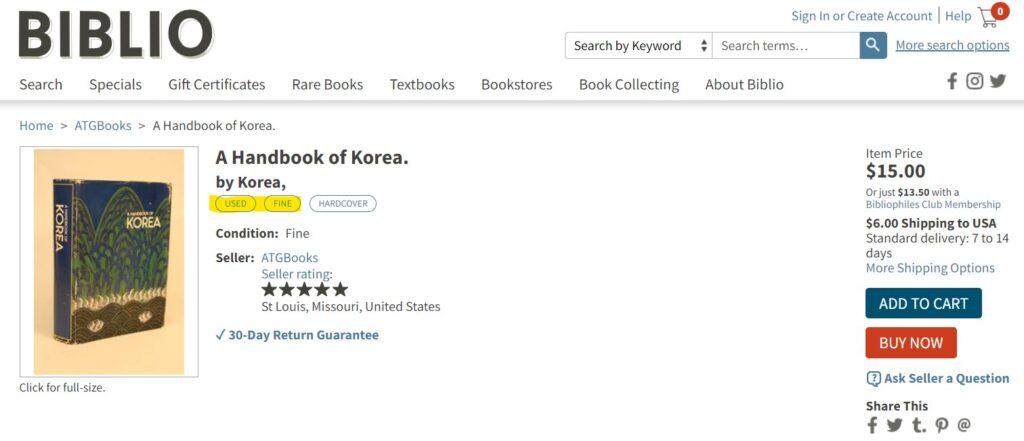
Image source: Biblio
Feel free to check out Biblio reviews on BookScouter.com.
Very Good (VG)
Books with small signs of wear but no tears on either binding or pages are usually conditioned as Very Good. This condition allows slight flaws such as fading or staining but not too much. A book having Very Good as a description should still look really good. Here’s another example from AbeBooks:
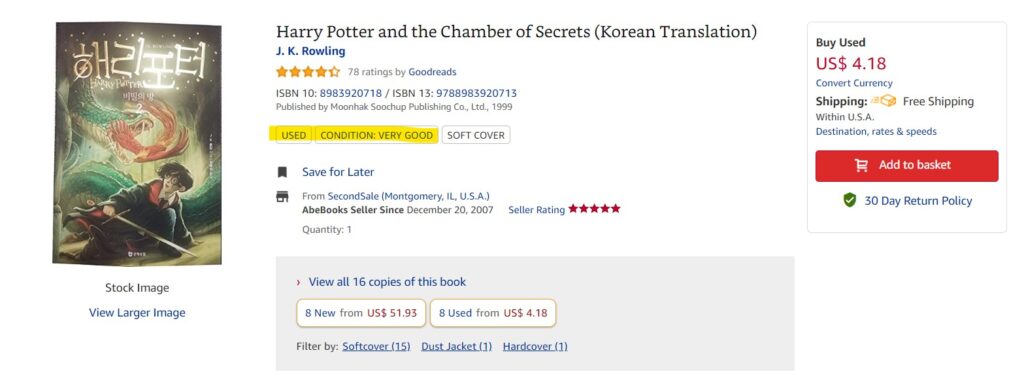
Image source: AbeBooks
Good (G)
Let’s proceed to books described as Good. This term covers any average used book that has been fairly worn but still has all pages present and a relatively good jacket. In this example from Half Price Books, we can’t see the actual photo of a book, so it’s hard to tell how exactly worn is the book we’re buying. However, if it’s rated as Good, it’s probably been read many times, so you can’t expect it to be impeccable.
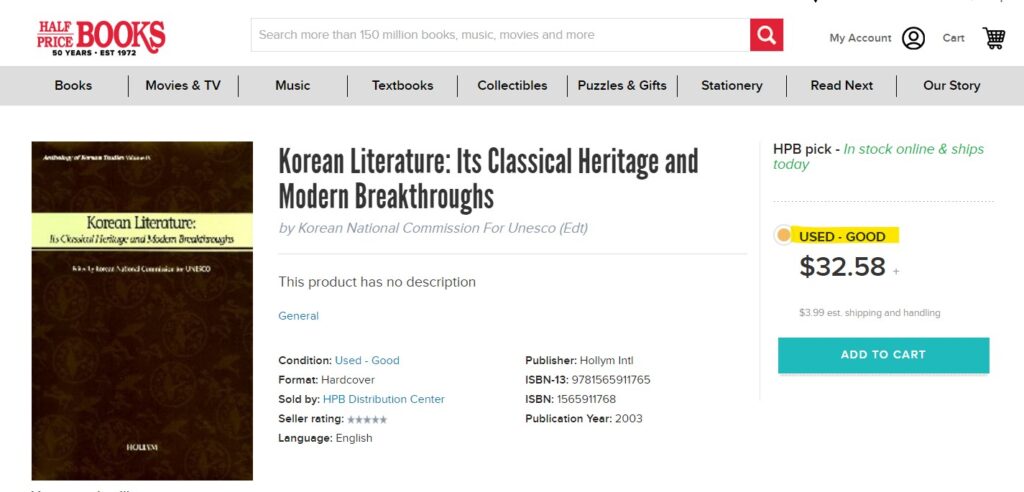
Image source: Half Price Books
Fair
When you see a book rated as Fair, be prepared to get a worn book that has been read and opened a lot. It has all the text pages but may lack some other pages, such as endpapers, etc. It’s probably slightly damaged, with both the binding and dust jacket bearing signs of wear. Here’s an example from AbeBooks:
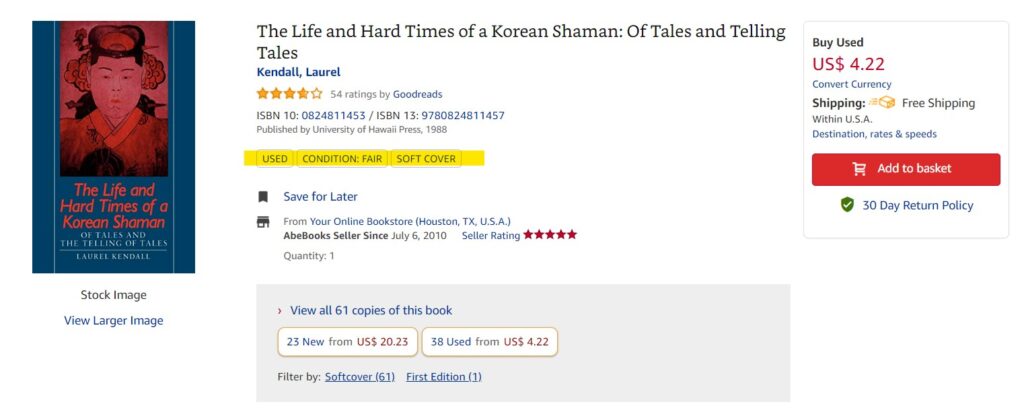
Image source: AbeBooks
Poor
The book listed as Poor bears signs of heavy wear and may have missing pages and other flaws such as spots, stains, loose joints, creases on pages, etc. Such books are hard to sell, so many booksellers don’t accept them for buyback and prefer not to deal with them. However, here on Half Price Books, you can see that they have Poor as one of the conditions listed:
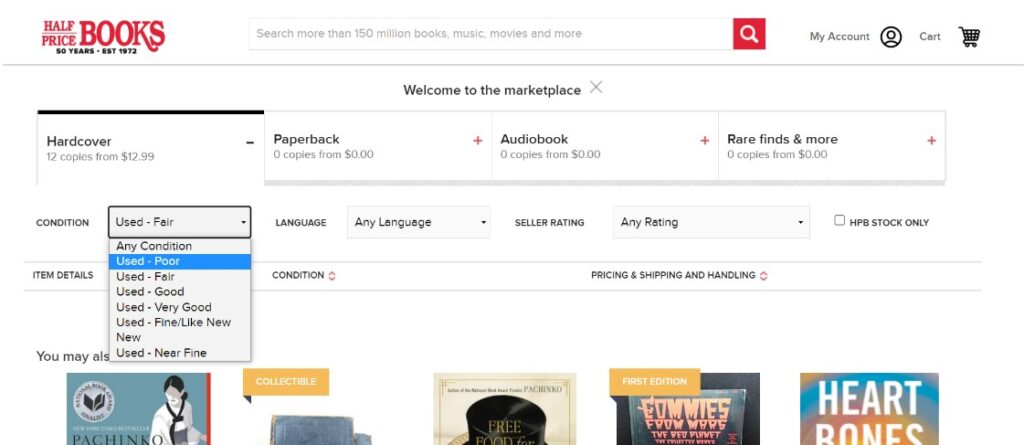
Image source: Half Price Books
Ex-library
Ex-library copies should always be labeled as such, no matter what the condition of the book. As the name suggests, ex-library copies are former library books that used to belong to this or that library. They are highly likely in good or worse condition and contain library acquisition and/or ownership stamped markings. The Ex-library term doesn’t usually go as a part of a conditions list (though it can, as in this AbeBooks example) and is mentioned somewhere in a detailed description of the book below:
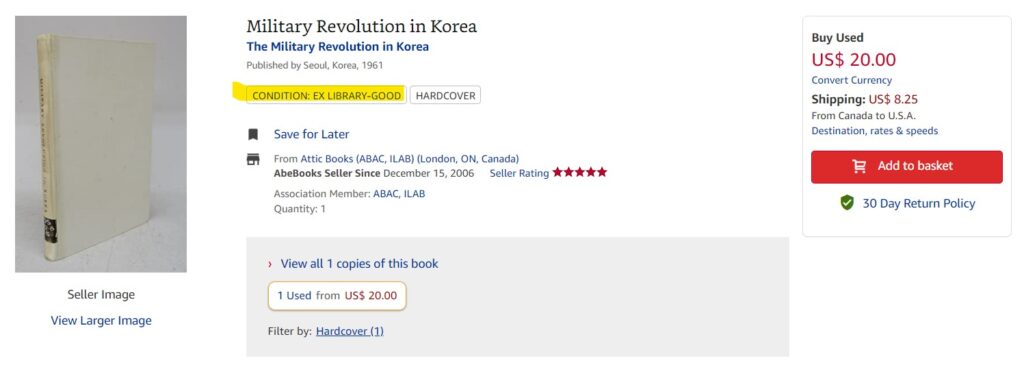
Image source: AbeBooks
Book Club Edition
Book Club copies, too, should always be labeled as such, no matter the condition of the book. The Book Club copy is usually an inexpensive, poor-quality reprint, cheap with little value. Book Club editions are usually sold by subscription to book club members. They don’t present any interest to book collectors, and it’s important to note that the Book Club edition is the one—not to mislead a buyer. This information can be found somewhere in a detailed description of the book, like in this AbeBooks example:
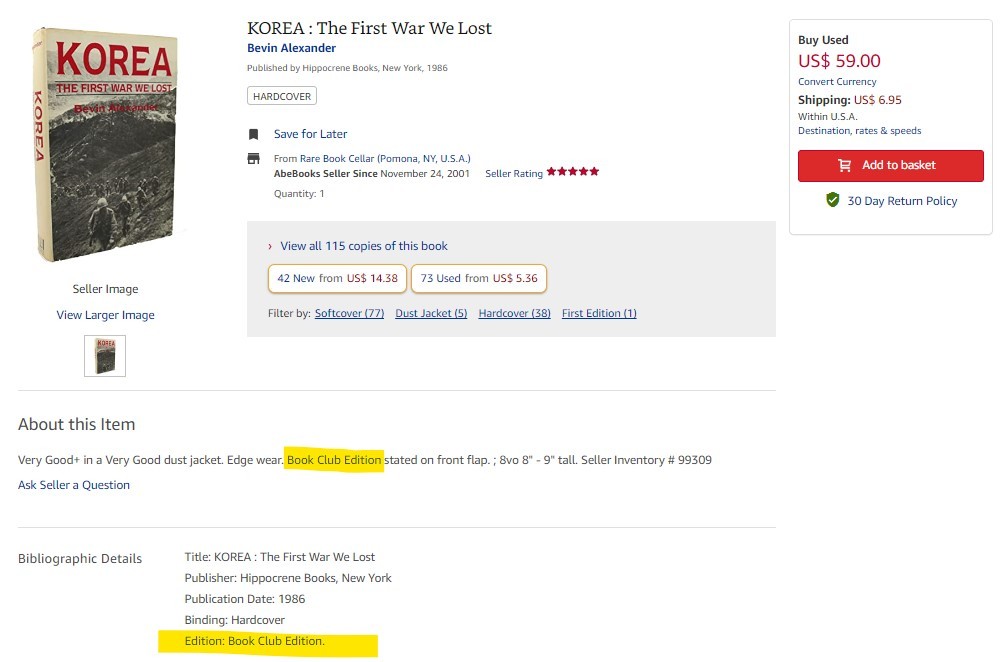
Image source: AbeBooks
Binding Copy
This is one of the book characteristics you can see on a book page. Simply put, a Binding Copy is a book that badly needs a new binding since the original is damaged. The book usually has all the pages or leaves in perfect condition; it’s the binding that needs to be attended to. Look for this information somewhere in a book description, like in this example:
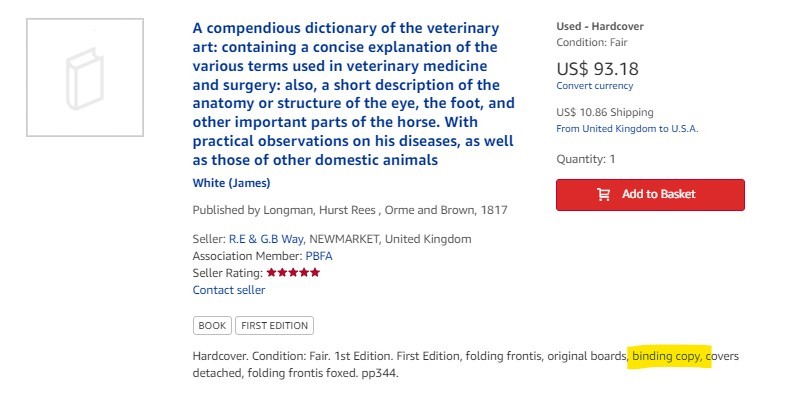
Image source: AbeBooks
Reading Copy
A reading copy isn’t exactly one of the book condition grades, but it usually signifies a well-worn copy of a book in poor or fair condition, with defects or damages but is quite fit for reading. It has no appeal to book collectors unless probably after rebinding.
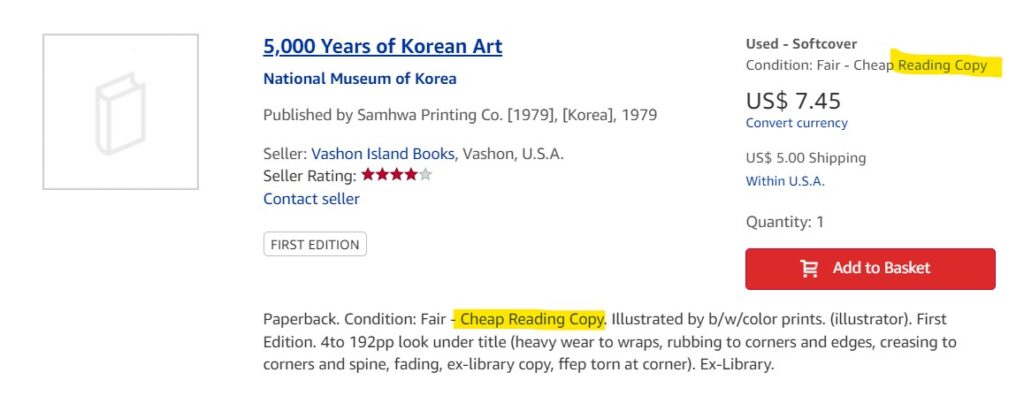
Image source: AbeBooks
Here is an example of a book that can be listed as a Reading Copy:
Book Condition Rating System Examples
Amazon’s Book Condition Ratings
Now, let’s move on to Amazon. Being the largest and the most popular bookselling platform, it has its own general condition guidelines for listing any product—in our case, books specifically—in its marketplace.
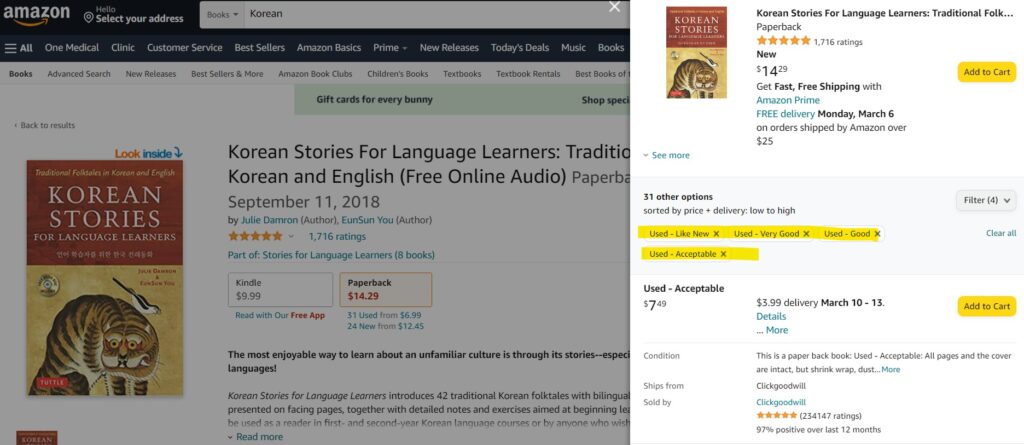
Image source: Amazon
As you can see on the screen above, Amazon places all the possible variations of the book and their condition grades on the window to the right. So you can immediately choose the price-quality ratio that suits you.
As opposed to the book condition rating system we’ve described earlier, Amazon sets three categories for books to be sold on the marketplace:
- New
- Used
- Collectible
New Books
New books are new books; there’s not much to explain. It should be in pristine condition as if it has just come directly from the publisher or very close to it.
Used Books
Things get more interesting here. To be listed on Amazon, used books should be able to meet the following book condition guidelines and be classified into any of the four groups.
- Used – Like New
- Used – Very Good
- Used – Good
- Used – Acceptable
Amazon’s book condition ratings are somewhat similar to the book condition ratings we described earlier. Like New describes the same book conditions as in As New; Very Good and Good also designate the same relatively good book conditions where cosmetic defects or flaws are either absent or minor. The only difference is that Amazon singles out one category for everything from Fair to Poor, with all sorts of additional descriptions (e.g., reading copy, etc.) that we’ve covered earlier into one—Acceptable. Here come all the books that have been fairly worn but continue to function properly. The category may include copies with limited notes, some highlighting, minor page defects, minor water damage, etc.
Collectibles
Amazon also lists collectibles—books that have features that will attract collectors. These books also fall into four categories according to their condition. However, in this guide, we’ll only mention the collectibles, as this is an entirely independent category and should be discussed separately.
- Collectible – Like New
- Collectible – Very Good
- Collectible – Good
- Collectible – Acceptable
Unacceptable Books
Amazon has a strict policy on the books they don’t allow to sell on their marketplace. Here’s what can’t be listed:
- Counterfeit or photocopied book
- Restricted book inventory
- Books that haven’t been published yet
- Expired books
- Books with missing pages
- Books with “Not for Sale” labels (like instructor edition textbooks)
- Books that are meant to be destroyed
- Books with texts that cannot be read
- Books with significant damage
You can learn more about Amazon book condition ratings by going through their guidelines.
AbeBooks Book Condition Rating Scale
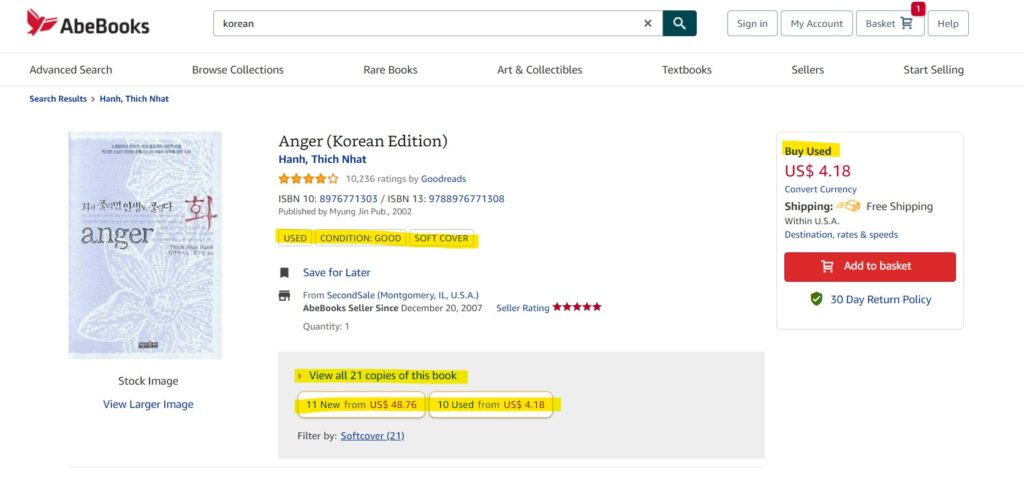
Image source: AbeBooks
AbeBooks follow the general book grading scale we described earlier. They list books according to these states:
- As New
- Fine (F or FN)
- Very Good (VG)
- Good (G)
- Fair
- Poor
- Binding Copy
- Reading Copy
Plus, there’re additional conditions that AbeBooks uses to describe the used books they sell:
- Bowed (refers to the state of the covers or boards of a hardcover book)
- Chipped (refers to books with small pieces missing from the edges)
- Dampstained (refers to a book with light stains)
- Darkening or Fading (refers to a book that has been exposed to light, etc.)
- Edgeworn (refers to wear along edges)
- Trimmed (refers to a book with pages cut down to a size smaller than the original).
- Etc.
Check AbeBooks’ entire book condition rating scale to know about all the related terms and how they describe used, rare, and collectible books.
Alibris Book Condition Grades
Alibris goes with a similar scheme. Here in the example, you can see how they rate a book, and if you click on the term, you can read the explanation for it in a pop-up window:
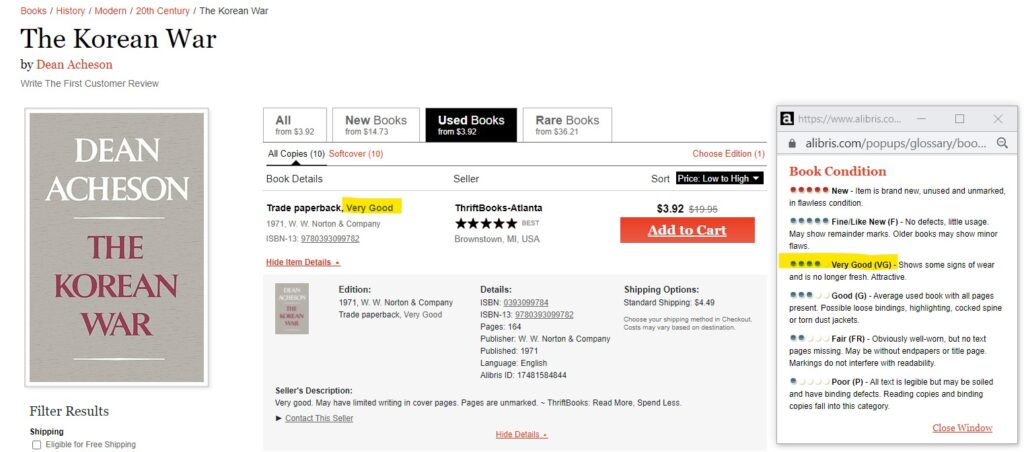
Image source: Alibris
Alibris follows a similar book condition grade with slight differences in terms:
- New or Very Fine—a book in a pristine condition
- Fine (F or FN)—close to new, but not quite
- Near Fine (NRF)—a few small flaws are detectable
- Very Good (VG)—a sound and collectible copy with some visible flaws present
- Good (G)—not collectible but otherwise perfectly readable
- Fair (F)—a worn book with complete text and pages but something lacking, with defects
- Poor (P)—a very worn book
Among other descriptors that Alibris uses to describe the used books are:
- Cocked (refers to a slanted book)
- Chipped (refers to books with small pieces missing from the edges)
- Dampstained (refers to a book with some light moisture staining on the cover or leaves of the book)
- Loose (refers to a book with a loose binding)
- Edgeworn (refers to a book with worn edges of hardback covers)
- Laid-in (refers to a book containing something that’s lying loose inside it)
- Ex-library (Ex-lib.) (refers to a book that used to be a former library copy)
- Foxing (refers to a book with rusty brown spotting caused by paper acidification; common in 19th-century books)
- Shelf Wear (refers to the signs of wear on book edges that occurs from rubbing against a shelf)
Check their book condition rating system and guidelines on their website.
eBay Book Condition Grades
eBay uses its own grade to determine the condition of books and magazines that can be sold on the platform:
- Brand new—a book is new, unread, and unused in perfect condition
- Like new—a book looks new but has been read
- Very good—a book does not look new and has been read but is in excellent condition
- Good—a book has been read but is in good condition
- Acceptable —a book with obvious signs of wear
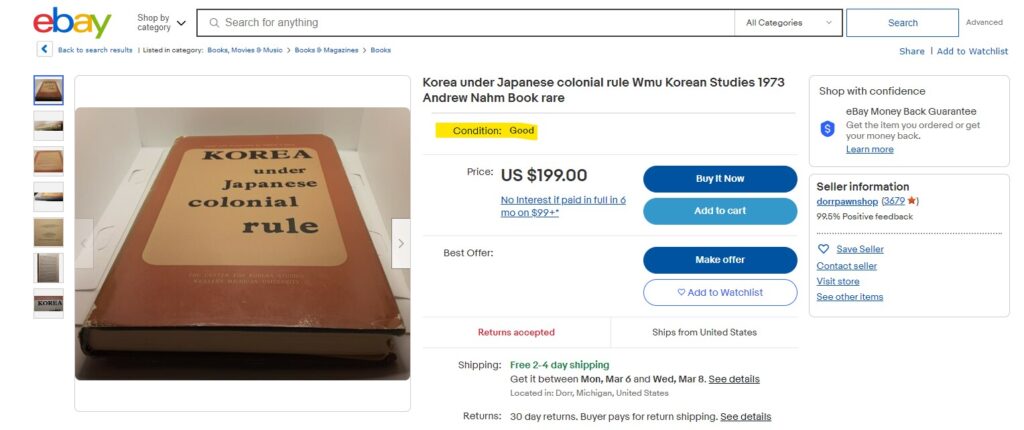
Image source: eBay
The thing about eBay’s book condition grades is that they aren’t exactly the same as the ones we discussed earlier. Many seasoned booksellers note that there’s very little room between “Brand New,” “Like New,” and “Very Good,” and with eBay, practically any flaw sends a book to “Good.” That’s why most of them recommend downgrading your books when you list them on eBay. However, we’ll cover the practical recommendations on how to determine book conditions in one of our future posts. Now simply take into consideration that eBay’s system isn’t the same as Amazon’s or AbeBooks’; you have to differ.
The Strand Book Condition Rating System
The largest and oldest bookstore in New York that accepts books for sale uses the following rating system:
- New —a brand new book that hasn’t been sold before
- Used – Good —a used book with some signs of wear and tear, with or without a dust jacket
- Used – Very Good —a used book that looks like new, with minor marks
- Rare – Good —a rare and collectible item with signs of wear and tear
- Rare – Very Good—a rare and collectible item that’s almost as good as new
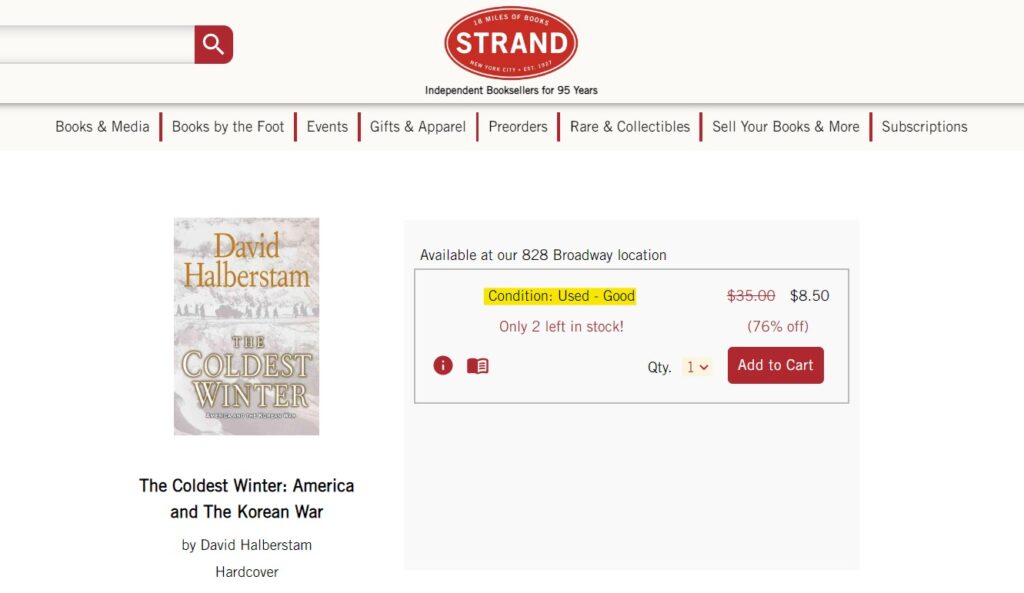
Image source: Strand
You can check how to sell used books to the Strand and what books they accept on their Frequently Asked Questions page.
Half Price Books Book Condition Guide
Half Price Books, the largest family-owned bookstore with 120+ stores across the country, is another place that you can check to understand how booksellers condition used books. Here are the six major conditions they use to describe books on their website:
Fine/Like New (F)—a used book that looks like new but may have been read; no defects
Near Fine (NF)—a used book without defects but with slight wear signs at the edges of the book or dust jacket
Very Good (VG)—a used book with distinctive signs of wear, minor defects, reminder marks, foxing or bumping
Good (G)—a used book in relatively good condition with all pages present but quite distinct signs of wear and tear, visible defects such as water damage, etc.
Fair (FR)—a worn, used book with certain signs of damage
Poor (P)—a very worn used book with extensive damage signs resulting from different causes, from water damage to insects, etc.
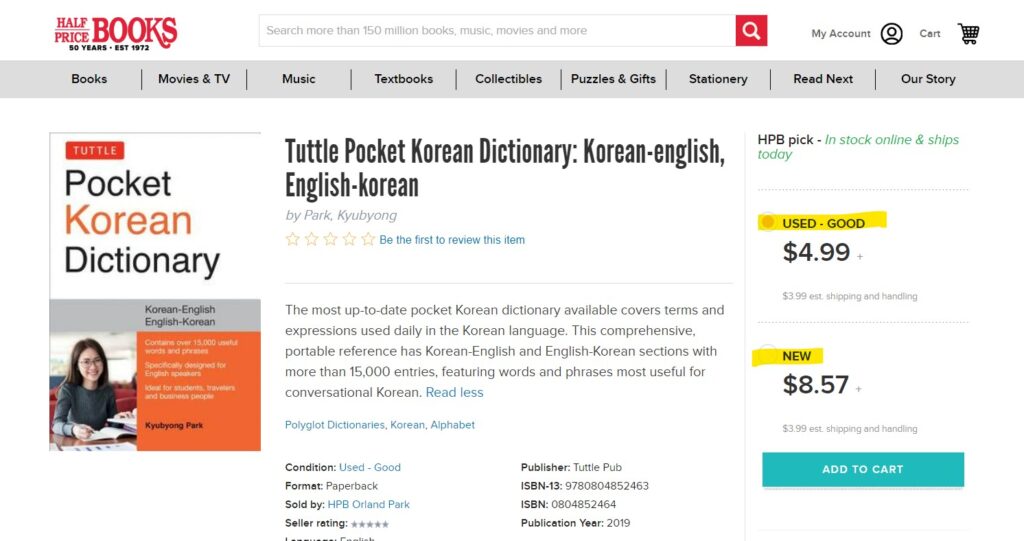
Image source: Half Price Books
Half Price Books also accept rare and collectible items; however, we’re not covering the guidelines for them in this guide. More about the book conditioning from Half Price Books can be found on their website.
Book Condition Grades Comparison Chart
For your convenience, we’ve compiled the bookselling platforms and their book condition rates comparison into one chart. We’ve tried to compare their ratings based on a 1 to 5 scale to make it more eloquent, taking into account the differences in the approaches. We hope that it’ll make each system more comprehensive when you try to check a book across several booksellers:
| Comparative grades |  |
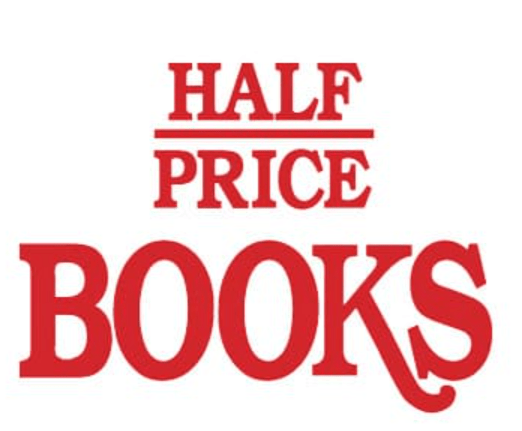 |
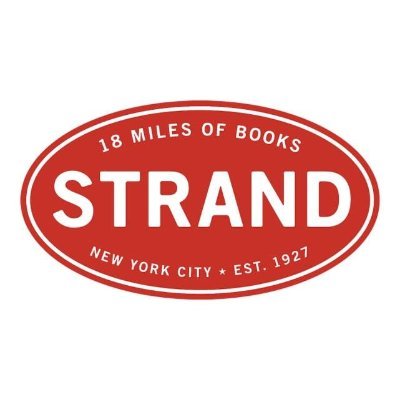 |
|||
| 5/5—New, As New | New |
Brand new |
As New |
New Very Fine |
Fine Like New (F) |
New |
| 4/5—Fine, Very Good |
Like New Very Good |
Like new Very good |
Fine (F or FN) Very Good (VG) |
Fine (F or FN) Near Fine (NRF) Very Good (VG) |
Near Fine (NF) Very Good (VG) |
Very good |
| 3/5—Good | Good |
Good |
Good (G) |
Good (G) |
Good (G) |
Good |
| 2/5—Acceptable | Acceptable |
Acceptable |
Fair | Fair (F) |
Fair (FR) |
– |
| 1/5—Everything else | Unacceptable | – | -Poor
-Binding Copy -Reading Copy |
Poor (P) | Poor (P) | – |
The Final Thoughts
Whether you’re an occasional book buyer or a seasoned reseller, knowing the details and the basic rules of how book conditions are determined is essential. Selling used books can be profitable, but you must understand what you are selling and how to do it before starting. We hope that now you understand the book conditions better; next time, we’ll tell you all about determining book conditions. So wait for the Determining Book Condition Guide soon.



